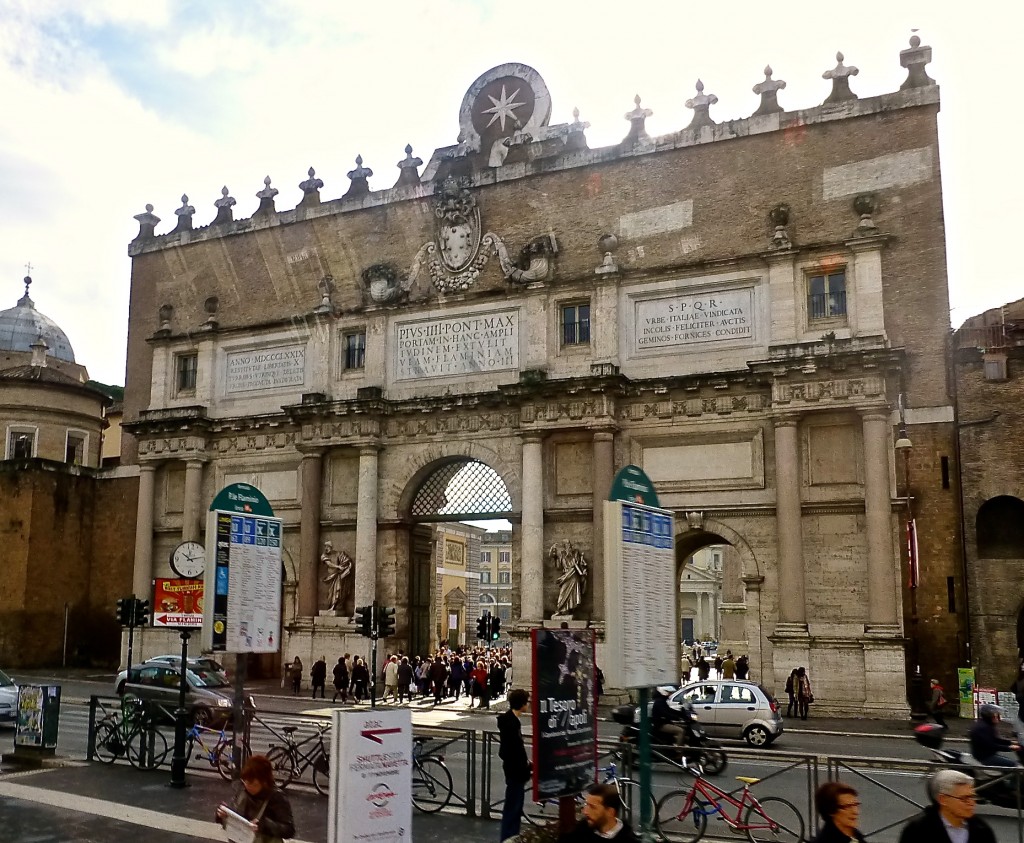Rome Notes
Plaza Del Popolo: The entrance, just two blocks from the Tibre River and four from the Vatican, was
starting point of our visit to Rome.
“When in Rome, do as the Romans do.” Well, I don’t know exactly what the Romans do that is terribly different from what we do, but whatever it was is, we certainly had fun. The sky was clear, the temperature around 20 and the crowds very light.
Our tour guide on the one-hour (plus) trip from Cittivencia to downtown Rome, set the tone with his humorous cynicism about Rome, Italian people, the Vatican and the foibles of Italian politicians and any others who came into his sights.
For instance, when passing the Vatican: “Did you know that Vatican Radio is the most powerful radio station in the world? If you put a finger up your nose and your other hand over your ear, you can hear Vatican Radio.”
“Do you know which country has the highest percentage of Christians? Answer: The Vatican, as it was given a plot of land by Mussolini in exchange keeping quiet about the war. Following the war it became an independent country with its own police and laws that governed only the Vatican. Rome now receives more ambassadors than any other country in the world – one for Italy, one for Rome and one for the Vatican.”
“You must be careful of pick pockets – they can steal the socks off you feet without touching your shoes.”
“Now all these stories about gladiators being killed in the coliseum – not true. They were professional sports athletes like professional sports athletes today – they were paid huge salaries. Do you think the owners of those gladiators would want them killed – did not happen.”
“It is said that Nero ordered the killing of Christians in the Coliseum – not true. Nero died in 68 AD, the coliseum was not completed until 72 AD.”
And so went the stories, jokes and tidbits of information for the entire trip. For Rome we opted to explore on our own as it was reported this was on the cusp of the season and access to various sites took only minutes not hours as is the case in peak season.
From the Plaza Del Popolo we headed directly south to Roman Ruins and Coliseum where we spend a couple of hours nosing around in very light crowds. As our guide had explained: “The construction of new cities over the centuries, was build on the ruins of the old, so much so that if you tired to excavate everything underneath, the most recent city would collapse.” Well, plenty of excavation has taken place and that which has been uncovered is breathtaking.
Guide: “Did you know the stadium held 55,000 spectators?”, then continued: “and it only took them 20 minutes in and 20 minutes out. We can’t do that today, can we?”
When the Roman Empire collapsed, the city went from 1.5 million to 10,000. Much of the best of the best granite was taken to the Christian side of the river and today is built into much of the Vatican. Reconstruction in Rome today is done with stone.
We then continued south to TIbre Tibre river, but of the twenty-six bridges built over the river by the Romans, four are still in use today – three by pedestrians and one by motor vehicles. Of the thirteen aqueducts built to supply water to Rome, four are still in use.
Following lunch at small underground restaurant, we continued down the Tibre, then crisscrossed the city as we visited a number of historic sites: The Palladium, Piazza Di Trevi fountains, Spanish Stairs and several less well know sites along our route.
(567)
Trackback from your site.

